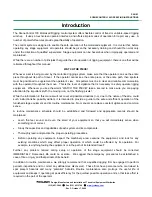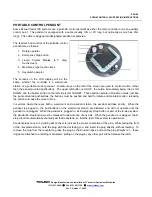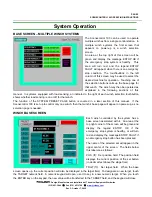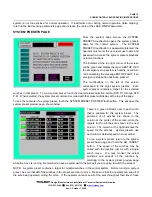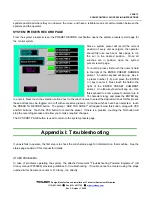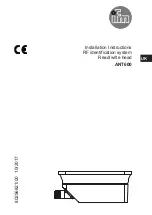
PAGE 1
SCENECONTROL 100 OPERATING INSTRUCTIONS
Introduction
The SceneControl 100 Motorized Rigging control system offers flexible control of fixed or variable-speed rigging
winches. It uses a touchscreen operator interface, and offers simple modes of operation for rapid, easy use. A
number of powerful features provide great flexibility of operation.
The control system is designed to enable the safe operation of the motorized equipment. It is crucial that, before
operating any stage equipment, all operators should be given the necessary training and should then work only
under the direction of qualified supervisors. Stage equipment can be hazardous when improperly operated and
maintained.
While there are a number of principles that guide the safe operation of rigging equipment, there is one that will be
reiterated throughout this manual:
WATCH THE PIECE!
Whenever a set is being moved by the motorized rigging system, make sure that the operator can see the entire
piece throughout its path of travel. If the operator cannot see the entire piece, or the entire path, then spotters
must be positioned to supplement the operator's view. All spotters must be in clear and reliable communication
with the operator throughout the move. This is the level of vigilance that is necessary to safely operate rigging
equipment. Whenever you see the words “WATCH THE PIECE!” take a second to make sure you are paying
attention to the important stuff - the moving iron, not the flashing pixels!
While the information in this manual will not cover all possible situations (nor, due to the nature of theatre, could
such instructions be possibly written), it is intended to provide a guide to the safe and efficient operation of the
furnished stage equipment and its routine maintenance. No manual can replace constant vigilance and common
sense.
A routine maintenance schedule should be established and followed and appropriate records should be
maintained.
•
Learn the feel, sound, and even the smell of your equipment so that you will immediately sense when
something is not correct.
•
Study the capacities and capabilities of each system and its components.
•
Thoroughly learn and practice the proper operating procedures.
•
Before operating any equipment, inspect the machinery area, examine the equipment, and look for any
existing conditions which may affect proper operation or which could be affected by its operation. For
example, is anything fouling the equipment or in the path of its intended travel?
Further, any problem noticed during setup or operation of the stage equipment should be corrected
IMMEDIATELY. Someone’s life could be at stake. We suggest that emergency procedures be established in
case of fire or injury and that periodic drills be held.
In addition to routine maintenance, we strongly recommend that a qualified rigging firm be engaged to perform
periodic inspections and to correct any deficiencies discovered. These firms have personnel who are trained to
spot present hazards and many “potential” hazards. Routine maintenance also prolongs the useful life of
equipment and keeps it operating at peak efficiency for the quietest possible operation and so that less effort is
required on the part of the operator.
Design, Manufacture and Installation of Theatrical Equipment Worldwide
(315) 451-3440
Fax (315) 451-1766
www.jrclancy.com
Rev 3: October 7, 2009



